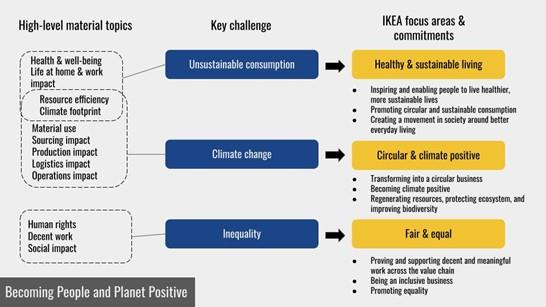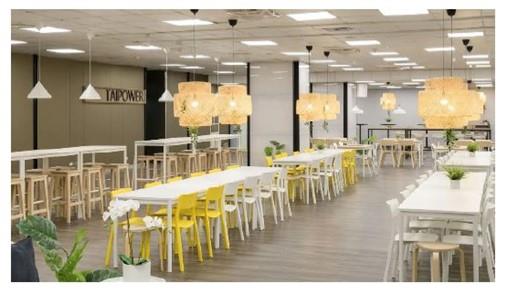IKEA has been recognized for its efforts to promote sustainable living and a circular economy. The furniture maker has pledged to become climate positive by 2030, including creating a fair and equal workplace and regenerating resources from end-of-life (EoL) products.
Furniture maker's sustainability interpretation
Every company has its own sustainability interpretation, including IKEA. IKEA's overall ambitions are to become more people and planet positive, not just by 2030 but continuously over the long term.
The furniture maker wants to inspire and enable people to live a better everyday life, while also understanding how the boundaries of earth can make that possible. In 2021, IKEA highlighted five dimensions of its sustainability, including healthy and sustainable living; becoming climate positive; transforming into a circular business; regenerating resources, protecting ecosystems, and improving biodiversity; and being fair and equal.
The People and Planet Positive strategy is based on the material topic diagram. IKEA considers these issues to be the most crucial sustainability issues because they have the ability to impact the triple bottom line.
When it developed the strategy, IKEA looked at what stakeholders expect from them, and where they could see them making the biggest positive changes. As an outcome, IKEA categorized the identified material topics into three key challenges, namely unsustainable consumption, climate change, and inequality.

Source: IKEA Sustainability Report. Credit: IKEA
Concept of the circular economy
With the increase in shortages of natural resources, serious damage to the environment, and extreme climatic conditions, along with excessive consumption and related problems caused by COVID-19, advocates are finding it necessary to rethink their priorities and sustainable goals. This has given rise to the concept of circular economy (CE). CE concerns closing, slowing, or narrowing resource loops.
Definition of the circular economy | |
Term | Definition |
Closing loops | A form of re-use where materials are being recycled |
Slowing Loops | It refers to the extended use and reuse of goods over time and the design of long-life products. |
Narrowing Loops | It concerns reducing resources used in production processes, thus increasing efficiency and sustainability. |
Source: Compiled by DIGITIMES Asia, June 2022.
IKEA has coined the term, "Circular IKEA" which is grounded on the principles of "take-make-distribute-use-recover." It is pledging to reach 100% materials closing loops by 2030. This elevates the question: "In what ways do IKEA franchisees align with Circular IKEA?"
The B2B furniture subscription is a blue ocean
IKEA has continued to pilot furniture subscription services for individual customers. But its franchisee in Taiwan has gone beyond that. They realized that B2B is a blue ocean. The Taiwanese team has successfully opened a whole new market in leasing furniture.
IKEA Taiwan, for instance, collaborates with Taiwan Power Company (Taipower) to launch the "Taipower Building Furniture Rental Project" in order to revitalize the staff restaurant atmosphere that has remained the same for nearly 40 years.

Taipower Building Furniture Rental Project; Credit: IKEA.
Nancy Wu, IKEA's Corporate and internal communication manager, North Asia, said, "The project has been put through a lot of thoughts and considerations."
"What kind of deal our partner would accept? What were the concerns in a leasing project? How much should we charge them?" She continued, "We agreed on the best course of action to take and make it official over a long-haul period."
This best exemplifies the concept of a "slow loop" as IKEA Taiwan has been extending furniture's life and using it again rather than throwing it away.
Wu said, "I won't say that our leasing project is the only case globally. But I am confident that it is the first successful commercial case among all IKEA franchisees."
There's always wisdom in challenges
A typical leasing business model turns a profit through the service fee, rather than from the "conventional" revenue from sales.
Wu said, "Just like we're able to handle the sales of furniture and market products, we can do the same for leasing by providing an ongoing monthly subscription service. However, in order to do this, we will have to take care of all the necessary costs."
The team, for example, won't be able to visit the site every day. How to keep IKEA's furniture in good condition without people breaking them is a separate consideration for leasing.
"One part is for the financial concern, and the other one is to make sure that our products stay in pristine condition," she concluded.
DIGITIMES Asia asked, "How does IKEA Taiwan address this problem?" "The key to unlocking this issue is finding the right partner," Wu replied.
Piloting the B2C model in North Asia
"This year, IKEA North Asia is trying out the second-hand market and the buyback program," said Wu.
More specifically, IKEA North Asia encourages its customers to sell their old furniture and reaches out to more customers by building a market for them.
The team is also considering running the buyback program. Customers can bring back their old furniture and IKEA North Asia will buy it back from them, redesign it, and resell it to customers in its stores.
In short, IKEA North Asia is making progress in their efforts of becoming a resource-efficient company. This process is called "narrowing loops."
There are some limitations that IKEA Taiwan hopes to address. "Right now, we want to decrease carbon emissions, but how do we do it? For instance, in most of the stores in Taiwan, we have solar panels on the roof ... If we want to reach the carbon-released balance, how can we get green power? What is the government's regulation on this? What does the government do to support companies? The government should provide direction and assistance to the private sector," she added.

IKEA North Asia's Buyback Program; Credit: IKEA Taiwan
Current and future state
For "health and sustainable living," IKEA Taiwan will continue to run different kinds of campaigns and activities to educate the customer on how to live a more sustainable life at home. As for the "fair and equal" part, "do you know whether or not we have a blue bag fund?" asked Wu. "The IKEA blue bag became popular quite quickly and has many positive reviews."
Customers who buy one can rest assured that they will be donating NT$5 per bag to a local community project. For instance, environmental activities for children, the makeover project for the local community in need, and energy poverty issues, to name a few.
In conclusion, DIGITIMES Asia summarizes Taiwan's Circular IKEA with the six main items outlined by McKinsey in the circular economy.
The ReSOLVE framework: Six action areas for businesses and countries wanting to move towards the circular economy | ||
Action area | McKinsey's Definition | North Asia IKEA's current status |
Regenerate | A broad set of actions that maintain and enhance the earth's biocapacity. | The use of renewable energy, the second-hand market, the buyback programs, the leasing project |
Share | The 'sharing economy' is a concept that overlaps with the circular economy. | The second-hand market, the buyback programs, the leasing project |
Optimize | This is about removing waste energy and materials in the manufacture of goods, and in the use of them as well. It also entails using technology to maximize resource use. | Increase performance/efficiency of the product, remove waste in production |
Loop | Where organic materials are composted in a circular economy, inorganic (or 'technical') materials are reused. | Closing, slowing, and narrowing loops |
Virtualize | Web-enablement of a given business application or process. | Dematerialize directly (i.e., e-newsletter) Dematerialize indirectly (i.e., online shopping) |
Exchange | The processes of swapping in new technologies, upgrading or replacing older ways of doing things. | New packaging method (i.e., flat packaging) |
Source: McKinsey (2015), Growth within: a circular economy vision for a competitive Europe. Compiled by DIGITIMES Asia, June 2022.



